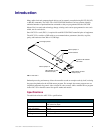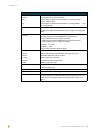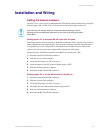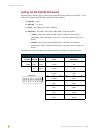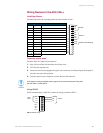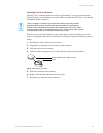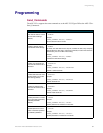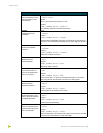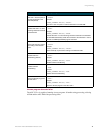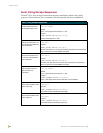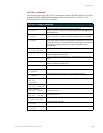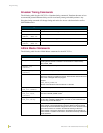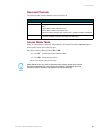
Programming
14
AXC-232++ RS-232/422/485 Interface Card
Xmodem Timing Commands
The following table lists the AXC-232++ Xmodem timing commands. Xmodem timeouts exist to
accommodate potential Ethernet delays and for consistency among and within products. Any
Xmodem timing command will change timing and retries for Axcess code download as well as
SOFTROM transfer.
AXlink Master Statements
The following table lists the AXlink Master statements for the AXC-232++.
Xmodem Timing Commands
Command Description
'TIMEOUT XX'
Xmodem timeouts via the Program Port. (Default is 10 sec.)
SEND_COMMAND
SERIAL, 'XMTO XX'
Over AXlink, where XX is from one to 50 seconds in 1-second increments.
'RETRY XX'
Xmodem retries via the Program Port. (Default is 5.)
SEND_COMMAND
SERIAL, 'XMRT XX'
Over AXlink where XX is from one to 10 in increments of one.
AXlink Master Statements
Statement Function
MIN_TO
Activates a channel or variable for a minimum amount of time-even if the corre-
sponding device-channel is released. The time duration is determined by
SET_PULSE_TIME.
ON[AXC_232,
channel]
Executes PUSH[0,channel] within AXC-232++.
OFF[AXC_232,
channel]
Executes RELEASE[0,channel] within AXC-232++.
PULSE
Turns on a channel or variable for a certain amount of time. Once the time
elapses, the channel or variable is turned off. The Pulse time remains the same
value until it is changed within the program.
Example:
SET_PULSE_TIME(12)
Sets the current duration of future Pulses to 1.2 seconds.
SEND_COMMAND
AXC_232,command
AXC-232++ interprets command.
SEND_LEVEL
AXC_232,level,
variable
Places the variable into the CREATE_LEVEL variable, if it were defined in the
AXC-232++ DEFINE_START section.
SEND_STRING
AXC_232,string
Places the string into the CREATE_BUFFER buffer, if you defined the buffer in
the AXC-232++ DEFINE_START section. If it were not, this command trans-
mits the string out the RS-232 port.
TO
Activates a channel or variable for as long as the corresponding
device-channel of its Push statement is activated. When the device-channel
referenced by the Push statement changes from off to on, the TO starts activat-
ing the device-channel or variable in the brackets following it. When the
device-channel of its Push is released, the TO statement stops activating its
device-channel or variable. For this reason, TO must be found only underneath
a Push statement.



